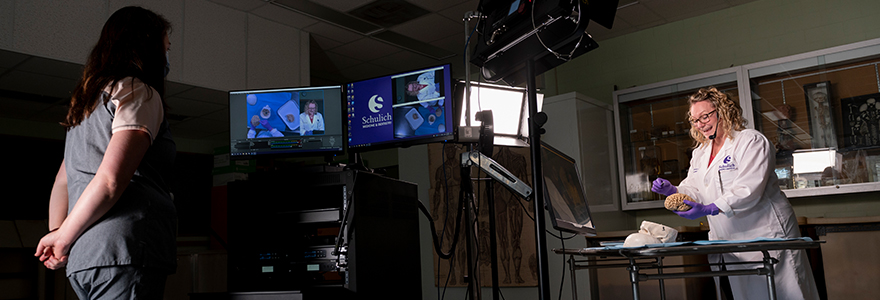Where anatomy meets innovation

When the outbreak of the pandemic prevented students from learning anatomy through in-person cadaveric dissection in the lab, Charys Martin, PhD, was forced to improvise, creating ‘Live from the Lab’
By Ashley Rabinovitch
Charys Martin, PhD, discovered her calling when she taught her first class as a master’s student in kinesiology at Western University. She enjoyed the exploratory process of shadowing physical therapists, physicians and athletic trainers, having developed an early interest in musculoskeletal anatomy.
“But nothing sparked as much joy as teaching anatomy for the first time and building relationships with students during the course of an academic year,” she remembers.
Today, the proud Western University lifer is a gross anatomist and Assistant Professor at Schulich Medicine & Dentistry, where she divides her time between teaching and developing curricula within Anatomy and Cell Biology.
Despite the buzz surrounding the use of new innovations like augmented reality to teach anatomy, Martin insists on maintaining a hands-on approach to teaching. “I’m a purist,” she acknowledged.
“There are certain aspects of anatomy you can’t get from augmented reality, because the human body exists in three dimensions. There’s no replacement for exploring structures and relationships with your own two hands.”
Instead, Martin has earned a reputation for creativity and innovation through the teaching methods she has pioneered, from holding yoga and fitness sessions with medical students in connection to their anatomy classes to embracing remote teaching during the COVID-19 pandemic.
When the outbreak of the pandemic prevented students from learning anatomy through in-person cadaveric dissection in the lab, Martin was forced to improvise.
“It was an enormous learning curve to show the students the specimen I was working on without having them present in the lab,” she remembered.
Through weeks of trial and error, she and her colleagues created a virtual ‘Live from the Lab’ educational format by cobbling together several pieces of technology – a GoPro camera that filmed Martin dissecting a specimen, a boom set up to move the GoPro around on a gooseneck arm, an old webcam focused on Martin from a different angle, and an SLR camera that provided a macro view.
“We called it Frankenstein because it combined so many different pieces of technology,” she said. With proof of concept, she and her colleagues received funding from Schulich Medicine & Dentistry for a more permanent, professional version they call Frank Pro.
Martin’s ‘Live from the Lab’ sessions can’t replace the kinesthetic, tactile learning that takes place in the lab, but the virtual environment offers distinct advantages. It allows multiple experts, including a clinician, pathologist and radiologist to host one teaching session with all the students at once instead of setting up multiple stations in a typical space.
Martin found these discussion times more productive, as chat functions provided a more organized system to field student questions and suggestions as they interacted with experts on the live stream.
Even when Martin’s students return to the lab for in-person dissection, she plans to continue using the system she devised so that students can enjoy a higher quality of video streaming as well as access a database of dissection videos to reinforce their learning before or after lab sessions.
“Nothing that we’ve created in the past year will be wasted,” she affirmed.
Outside of the lab, Martin has played an instrumental role in envisioning and implementing Schulich Medicine & Dentistry’s renewed curriculum.
“It was an exciting opportunity to dream big and think about how to align our curriculum more closely with evidence and educational scholarship,” she said.
Much like Martin’s lab sessions, where she invites colleagues from different disciplines to contribute their unique perspectives, the renewed curriculum focuses heavily on building channels for interdisciplinary collaboration and ensuring that content is clinically relevant.
Recognizing that curriculum renewal requires a certain amount of trial and error, Martin has launched a research project focused on knowledge retention. Before implementing the curricula, she tested third-year medical students to determine how much they had retained from basic science education as they entered clerkships and clinical rotations. She assessed students at the beginning and end of their rotations, concluding that across the board, clinical experience effectively reinforces basic science concepts.
“Our findings supported the concept of more integration between disciplines in the new curriculum,” she explained.
In the near future, she plans to test a new batch of students to determine whether the new curriculum has boosted scores.
“At the end of the day, my favourite part of the job is building relationships with students and coming up with ways to help them learn and retain the materials they need to succeed,” reflected Martin. “Our learners, our technology, and our environment are all very different from what they were even 20 years ago. It’s an exciting time to be at Schulich Medicine & Dentistry.”








